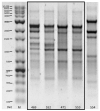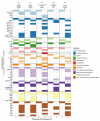Antibiotic-Resistant Enterobacteriaceae in Wastewater of Abattoirs
- PMID: 34065908
- PMCID: PMC8150771
- DOI: 10.3390/antibiotics10050568
Antibiotic-Resistant Enterobacteriaceae in Wastewater of Abattoirs
Abstract
Antibiotic-resistant Enterobacteriaceae are regularly detected in livestock. As pathogens, they cause difficult-to-treat infections and, as commensals, they may serve as a source of resistance genes for other bacteria. Slaughterhouses produce significant amounts of wastewater containing antimicrobial-resistant bacteria (AMRB), which are released into the environment. We analyzed the wastewater from seven slaughterhouses (pig and poultry) for extended-spectrum β-lactamase (ESBL)-carrying and colistin-resistant Enterobacteriaceae. AMRB were regularly detected in pig and poultry slaughterhouse wastewaters monitored here. All 25 ESBL-producing bacterial strains (19 E. coli and six K. pneumoniae) isolated from poultry slaughterhouses were multidrug-resistant. In pig slaughterhouses 64% (12 of 21 E. coli [57%] and all four detected K. pneumoniae [100%]) were multidrug-resistant. Regarding colistin, resistant Enterobacteriaceae were detected in 54% of poultry and 21% of pig water samples. Carbapenem resistance was not detected. Resistant bacteria were found directly during discharge of wastewaters from abattoirs into water bodies highlighting the role of slaughterhouses for environmental surface water contamination.
Keywords: Enterobacteriaceae; MDR; resistance; slaughterhouse; wastewater.
Conflict of interest statement
The authors declare no conflict of interest.
Figures


References
-
- World Health Organization . Antimicrobial Resistance Global Report on Surveillance. WHO; Geneva, Switzerland: 2014.
-
- Tacconelli E., Carrara E., Savoldi A., Harbarth S., Mendelson M., Monnet D.L., Pulcini C., Kahlmeter G., Kluytmans J., Carmeli Y., et al. Discovery, Research, and Development of New Antibiotics: The Who Priority List of Antibiotic-Resistant Bacteria and Tuberculosis. Lancet Infect. Dis. 2018;18:318–327. doi: 10.1016/S1473-3099(17)30753-3. - DOI - PubMed
LinkOut - more resources
Full Text Sources
Research Materials

